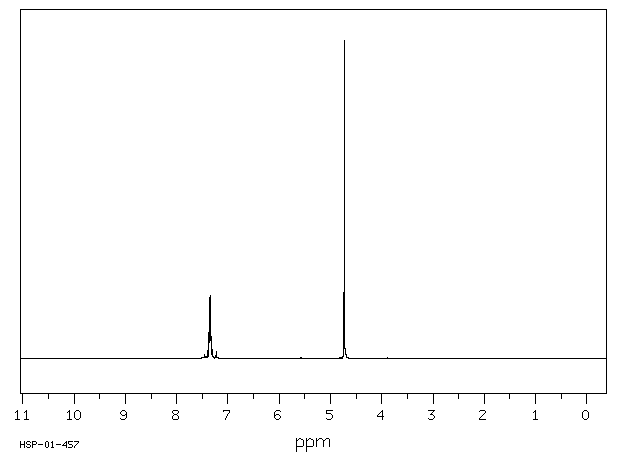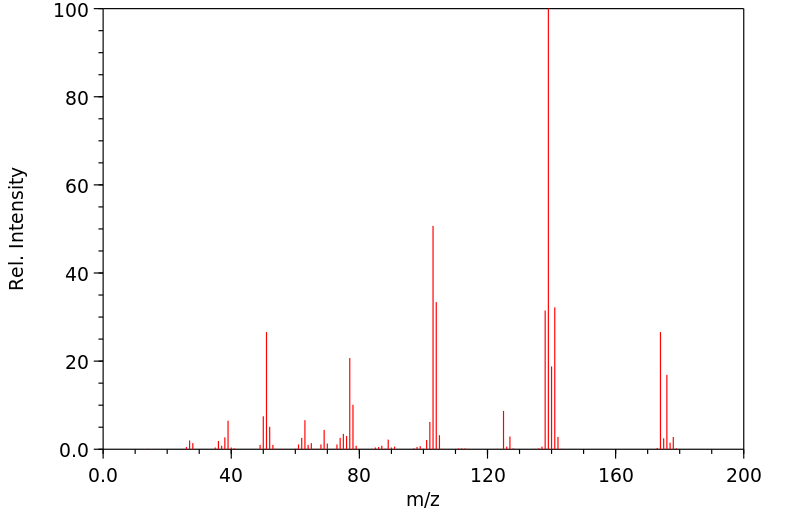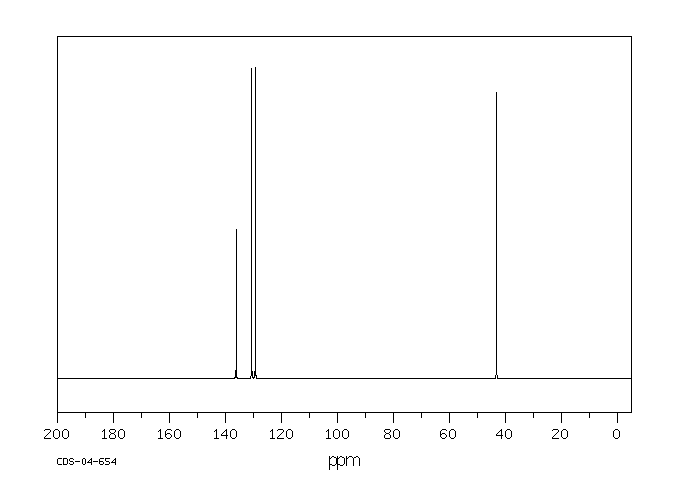邻二氯苄 | 612-12-4
中文名称
邻二氯苄
中文别名
邻二氯亚二甲苯基;邻亚二甲苯二氯;邻苯二甲基二氯;O-二氯苄;ALPHA,ALPHA'-二氯邻二甲苯;Α、Α'-二氯邻二甲苯;1,2-二氯苄;α,α'-二氯邻二甲苯
英文名称
o-Xylylene dichloride
英文别名
α,α'-dichloro o-xylene;1,2-bis(chloromethyl)benzene;α,α′-dichloro-o-xylene
CAS
612-12-4
化学式
C8H8Cl2
mdl
MFCD00000903
分子量
175.058
InChiKey
FMGGHNGKHRCJLL-UHFFFAOYSA-N
BEILSTEIN
——
EINECS
——
-
物化性质
-
计算性质
-
ADMET
-
安全信息
-
SDS
-
制备方法与用途
-
上下游信息
-
文献信息
-
表征谱图
-
同类化合物
-
相关功能分类
-
相关结构分类
物化性质
-
熔点:51-55 °C (lit.)
-
沸点:239-241 °C (lit.)
-
密度:1.3930
-
闪点:226 °F
-
溶解度:溶于甲醇
-
保留指数:1296
-
稳定性/保质期:
性质与稳定性:
在常温常压下,该物质不会分解。
计算性质
-
辛醇/水分配系数(LogP):2.7
-
重原子数:10
-
可旋转键数:2
-
环数:1.0
-
sp3杂化的碳原子比例:0.25
-
拓扑面积:0
-
氢给体数:0
-
氢受体数:0
安全信息
-
TSCA:Yes
-
危险等级:6.1
-
危险品标志:Xi,C
-
安全说明:S24/25,S26,S27,S28,S28A,S29,S36/37/39,S45,S61
-
危险类别码:R34,R36/37/38
-
WGK Germany:2
-
海关编码:29036990
-
危险品运输编号:UN 3261 8/PG 2
-
危险类别:6.1
-
RTECS号:ZE4085000
-
包装等级:II
-
危险性防范说明:P261,P280,P305+P351+P338,P310
-
危险性描述:H314,H335
-
储存条件:贮存: 将密器密封后,储存在密封的主要容器中,并放置在阴凉、干燥处。
SDS
模块 1. 化学品
1.1 产品标识符
: 邻二氯苄
产品名称
1.2 鉴别的其他方法
1,2-Bis(chloromethyl)benzene
o-Xylylene dichloride
1.3 有关的确定了的物质或混合物的用途和建议不适合的用途
仅供科研用途,不作为药物、家庭备用药或其它用途。
模块 2. 危险性概述
2.1 GHS分类
急性毒性, 经口 (类别5)
皮肤腐蚀 (类别1B)
眼刺激 (类别2A)
特异性靶器官系统毒性(一次接触) (类别3)
2.2 GHS 标记要素,包括预防性的陈述
象形图
警示词 危险
危险申明
H303 吞咽可能有害。
H314 造成严重皮肤灼伤和眼损伤。
H335 可能引起呼吸道刺激。
警告申明
预防
P260 不要吸入粉尘/烟/气体/烟雾/蒸气/喷雾。
P264 操作后彻底清洁皮肤。
P271 只能在室外或通风良好之处使用。
P280 戴防护手套/穿防护服/戴护目镜/戴面罩.
措施
P301 + P330 + P331 如误吞咽:漱口。不要诱导呕吐。
P303 + P361 + P353 如皮肤(或头发)沾染:立即去除/ 脱掉所有沾染的衣服。用水清洗皮肤/
淋浴。
P304 + P340 如吸入,将患者移至新鲜空气处并保持呼吸顺畅的姿势休息.
P305 + P351 + P338 如与眼睛接触,用水缓慢温和地冲洗几分钟。如戴隐形眼镜并可方便地取
出,取出隐形眼镜,然后继续冲洗.
P310 立即呼叫中毒控制中心或医生.
P321 具体治疗(见本标签上提供的急救指导)。
P337 + P313 如仍觉眼睛刺激:求医/就诊。 如仍觉眼睛刺激:求医/就诊.
P363 沾染的衣服清洗后方可重新使用。
储存
P403 + P233 存放于通风良的地方。 保持容器密闭。
P405 存放处须加锁。
处理
P501 将内容物/ 容器处理到得到批准的废物处理厂。
2.3 其它危害物
催泪
模块 3. 成分/组成信息
3.1 物 质
: 1,2-Bis(chloromethyl)benzene
别名
o-Xylylene dichloride
: C8H8Cl2
分子式
: 175.06 g/mol
分子量
组分 浓度或浓度范围
1,2-Bis(chloromethyl)benzene
-
CAS 号 612-12-4
EC-编号 210-291-8
模块 4. 急救措施
4.1 必要的急救措施描述
一般的建议
请教医生。 出示此安全技术说明书给到现场的医生看。
吸入
如果吸入,请将患者移到新鲜空气处。 如果停止了呼吸,给于人工呼吸。 请教医生。
皮肤接触
立即脱掉污染的衣服和鞋子。 用肥皂和大量的水冲洗。 请教医生。
眼睛接触
用大量水彻底冲洗至少15分钟并请教医生。
食入
禁止催吐。 切勿给失去知觉者从嘴里喂食任何东西。 用水漱口。 请教医生。
4.2 主要症状和影响,急性和迟发效应
该物质对粘膜组织和上呼吸道、眼睛和皮肤破坏巨大。, 咳嗽, 呼吸短促, 头痛, 恶心
4.3 及时的医疗处理和所需的特殊处理的说明和指示
无数据资料
模块 5. 消防措施
5.1 灭火介质
灭火方法及灭火剂
用水雾,耐醇泡沫,干粉或二氧化碳灭火。
5.2 源于此物质或混合物的特别的危害
碳氧化物, 氯化氢气体
5.3 给消防员的建议
如必要的话,戴自给式呼吸器去救火。
5.4 进一步信息
无数据资料
模块 6. 泄露应急处理
6.1 人员的预防,防护设备和紧急处理程序
使用个人防护设备。 防止粉尘的生成。 防止吸入蒸汽、气雾或气体。 保证充分的通风。
将人员撤离到安全区域。 避免吸入粉尘。
6.2 环境保护措施
不要让产物进入下水道。
6.3 抑制和清除溢出物的方法和材料
收集、处理泄漏物,不要产生灰尘。 扫掉和铲掉。 存放进适当的闭口容器中待处理。
6.4 参考其他部分
丢弃处理请参阅第13节。
模块 7. 操作处置与储存
7.1 安全操作的注意事项
避免接触皮肤和眼睛。 防止粉尘和气溶胶生成。
在有粉尘生成的地方,提供合适的排风设备。一般性的防火保护措施。
7.2 安全储存的条件,包括任何不兼容性
贮存在阴凉处。 容器保持紧闭,储存在干燥通风处。
7.3 特定用途
无数据资料
模块 8. 接触控制和个体防护
8.1 容许浓度
最高容许浓度
没有已知的国家规定的暴露极限。
8.2 暴露控制
适当的技术控制
按照良好工业和安全规范操作。 休息前和工作结束时洗手。
个体防护设备
眼/面保护
面罩與安全眼鏡请使用经官方标准如NIOSH (美国) 或 EN 166(欧盟) 检测与批准的设备防护眼部。
皮肤保护
戴手套取 手套在使用前必须受检查。
请使用合适的方法脱除手套(不要接触手套外部表面),避免任何皮肤部位接触此产品.
使用后请将被污染过的手套根据相关法律法规和有效的实验室规章程序谨慎处理. 请清洗并吹干双手
所选择的保护手套必须符合EU的89/686/EEC规定和从它衍生出来的EN 376标准。
身体保护
全套防化学试剂工作服, 防护设备的类型必须根据特定工作场所中的危险物的浓度和含量来选择。
呼吸系统防护
如危险性评测显示需要使用空气净化的防毒面具,请使用全面罩式多功能微粒防毒面具N100型(US
)或P3型(EN
143)防毒面具筒作为工程控制的候补。如果防毒面具是保护的唯一方式,则使用全面罩式送风防毒
面具。 呼吸器使用经过测试并通过政府标准如NIOSH(US)或CEN(EU)的呼吸器和零件。
模块 9. 理化特性
9.1 基本的理化特性的信息
a) 外观与性状
形状: 结晶
颜色: 棕灰色
b) 气味
无数据资料
c) 气味阈值
无数据资料
d) pH值
无数据资料
e) 熔点/凝固点
熔点/凝固点: 51 - 55 °C - lit.
f) 起始沸点和沸程
239 - 241 °C - lit.
g) 闪点
125 °C - 闭杯
h) 蒸发速率
无数据资料
i) 易燃性(固体,气体)
无数据资料
j) 高的/低的燃烧性或爆炸性限度 无数据资料
k) 蒸汽压
无数据资料
l) 蒸汽密度
无数据资料
m) 相对密度
无数据资料
n) 水溶性
无数据资料
o) n-辛醇/水分配系数
无数据资料
p) 自燃温度
无数据资料
q) 分解温度
无数据资料
r) 粘度
无数据资料
模块 10. 稳定性和反应活性
10.1 反应性
无数据资料
10.2 稳定性
无数据资料
10.3 危险反应的可能性
无数据资料
10.4 应避免的条件
防潮。
10.5 不兼容的材料
醇类, 碱, 胺, 氧化剂
10.6 危险的分解产物
其它分解产物 - 无数据资料
模块 11. 毒理学资料
11.1 毒理学影响的信息
急性毒性
半数致死剂量 (LD50) 经口 - 大鼠 - 2,263 mg/kg
备注: 行为的:嗜睡(全面活力抑制)。 血管的:局部或者全身小动脉或者静脉扩张
皮肤刺激或腐蚀
无数据资料
眼睛刺激或腐蚀
无数据资料
呼吸道或皮肤过敏
无数据资料
生殖细胞突变性
无数据资料
致癌性
IARC:
此产品中没有大于或等于 0。1%含量的组分被 IARC鉴别为可能的或肯定的人类致癌物。
生殖毒性
无数据资料
特异性靶器官系统毒性(一次接触)
吸入 - 可能引起呼吸道刺激。
特异性靶器官系统毒性(反复接触)
无数据资料
吸入危险
无数据资料
潜在的健康影响
吸入 吸入可能有害。 该物质对组织、粘膜和上呼吸道破坏力强
引起呼吸道刺激。
摄入 如服入是有害的。 引致灼伤。
皮肤 如果通过皮肤吸收可能是有害的。 引起皮肤烧伤。
眼睛 引起眼睛烧伤。
接触后的征兆和症状
该物质对粘膜组织和上呼吸道、眼睛和皮肤破坏巨大。, 咳嗽, 呼吸短促, 头痛, 恶心
附加说明
化学物质毒性作用登记: ZE4085000
模块 12. 生态学资料
12.1 生态毒性
无数据资料
12.2 持久存留性和降解性
无数据资料
12.3 潜在的生物蓄积性
无数据资料
12.4 土壤中的迁移性
无数据资料
12.5 PBT 和 vPvB的结果评价
无数据资料
12.6 其它不利的影响
无数据资料
模块 13. 废弃处置
13.1 废物处理方法
产品
将剩余的和未回收的溶液交给处理公司。 联系专业的拥有废弃物处理执照的机构来处理此物质。
与易燃溶剂相溶或者相混合,在备有燃烧后处理和洗刷作用的化学焚化炉中燃烧
受污染的容器和包装
作为未用过的产品弃置。
模块 14. 运输信息
14.1 联合国危险货物编号
欧洲陆运危规: 3261 国际海运危规: 3261 国际空运危规: 3261
14.2 联合国(UN)规定的名称
欧洲陆运危规: CORROSIVE SOLID, ACIDIC, ORGANIC, N.O.S. (1,2-Bis(chloromethyl)benzene)
国际海运危规: CORROSIVE SOLID, ACIDIC, ORGANIC, N.O.S. (1,2-Bis(chloromethyl)benzene)
国际空运危规: CorrOSiVE solid, acidic, organic, n.o.s. (1,2-Bis(chloromethyl)benzene)
14.3 运输危险类别
欧洲陆运危规: 8 国际海运危规: 8 国际空运危规: 8
14.4 包裹组
欧洲陆运危规: II 国际海运危规: II 国际空运危规: II
14.5 环境危险
欧洲陆运危规: 否 国际海运危规 海运污染物: 否 国际空运危规: 否
14.6 对使用者的特别提醒
无数据资料
模块 15 - 法规信息
N/A
模块16 - 其他信息
N/A
制备方法与用途
上下游信息
-
上游原料
中文名称 英文名称 CAS号 化学式 分子量 氯化苄 benzyl chloride 100-44-7 C7H7Cl 126.586 邻二甲苯 o-xylene 95-47-6 C8H10 106.167 邻苯二甲酰氯 Phthaloyl dichloride 88-95-9 C8H4Cl2O2 203.025 -
下游产品
中文名称 英文名称 CAS号 化学式 分子量 邻甲基氯化苄 1-chloromethyl-2-methylbenzene 552-45-4 C8H9Cl 140.612 1-(二氯甲基)-2-甲基苯 α,α-dichloro-o-xylene 60973-59-3 C8H8Cl2 175.058 [2-(氯甲基)苯基]甲醇 2-(chloromethyl)benzyl alcohol 142066-41-9 C8H9ClO 156.612 2-(氯甲基)苯甲醛 2-(chloromethyl)benzaldehyde 108683-62-1 C8H7ClO 154.596 2,3-双(氯甲基)萘 2,3-bis(chloromethyl)naphthalene 2744-60-7 C12H10Cl2 225.117 —— 1-(chloromethyl)-2-(methoxymethyl)benzene 68718-99-0 C9H11ClO 170.639 邻二甲苯 o-xylene 95-47-6 C8H10 106.167
反应信息
-
作为反应物:描述:邻二氯苄 在 polymer supported 'magnesium(anthracene)' 作用下, 以90%的产率得到Grignard reagent of o-xylylene dichloride参考文献:名称:聚合物负载的“镁(蒽)”:有效形成苄基格氏试剂(通过电子转移反应)摘要:由[Mg(蒽)(thf)3 ](1)在四氢呋喃(thf)中与带有–9-CH 2 SiMe 2(C 14)的聚苯乙烯反应,制得了聚合物负载的“镁(蒽)”(4)。H 9)组(3);包含二价阴离子和自由基阴离子蒽位点的绿色顺磁性固体,通过电子转移反应在三氟甲烷中生成格氏试剂(> 90%)和苄基卤化物,二价阴离子位点的模型化合物也是如此。[Mg {9-PhCH 2 SiMe 2(C 14 H 9)}(thf)2](6)。DOI:10.1039/c39880000652
-
作为产物:参考文献:名称:Intestinal permeability in adult patients with growth hormone deficiency摘要:Pathological disruption of the intestinal mucosa increases the paracellular pathway, leading to an increase in the penetration of large molecules. Since growth hormone (GH) has a trophic intestinal effect, we used a double marker test to enable examination of intestinal permeability, which reflects the state of integrity of the intestinal mucosa, We recruited 22 adult patients, mean age 54+/-13.3 years, with GH deficiency due to partial or total hypopituitarism. None had received GH treatment at any time, although they were all in optimized replacement therapy. A control group was composed of 19 healthy age-matched relatives. The intestinal permeability test was performed with lactulose (5 g) and mannitol (1 g) after an oral load of 100 mi of aqueous solution. The urinary lactu- lose/mannitol ratio and the percentages of lactulose and mannitol excreted were determined on a 5-h urine collection. There were no significant differences between the patients and the control group in the lactulose/mannitol ratio (0.087+/-0.059 vs 0.077+/-0.064, respectively) or in the urinary excretion percentages of lactulose (0.067+/-0.048% vs 0.073+/-0.070%, respectively) or mannitol (5.127+/-3.269% vs 5.068+/-2.985%, respectively). In conclusion, no increase in intestinal permeability was detected in patients with GH deficiency, so that in spite of the known trophic effects of GH on the epithelial crypt cells, there was no intestinal hyperpermeability in these patients. (C) 2001, Editrice Kurtis.DOI:10.1007/bf03343817
-
作为试剂:参考文献:名称:Organic Process Research and Development 2001, 5, 9-15摘要:DOI:
文献信息
-
ヘテロシクロアルキル環を含むアミド誘導体申请人:第一三共株式会社公开号:JP2020045306A公开(公告)日:2020-03-26【課題】本発明は、優れたEP300および/またはCREBBPのヒストンアセチルトランスフェラーゼ阻害活性を有する化合物またはその薬理上許容される塩を提供するものである。【解決手段】式(1)で表される化合物またはその薬理上許容される塩。【化1】(ここで、式(1)中の環Q1、環Q2、環Q3、X、およびLは、それぞれ明細書中の定義と同義である。)【選択図】なし本发明提供具有优良的EP300和/或CREBBP的组蛋白乙酰转移酶抑制活性的化合物或其药理上可接受的盐。该化合物或其药理上可接受的盐由式(1)表示。在此,环Q1、环Q2、环Q3、X和L在式(1)中分别与说明书中的定义同义。【选择图】无
-
Flash vacuum pyrolysis over magnesium. Part 1. Pyrolysis of benzylic, other aryl/alkyl and aliphatic halides作者:R. Alan Aitken、Philip K. G. Hodgson、John J. Morrison、Adebayo O. OyewaleDOI:10.1039/b108663d日期:2002.1.23Flash vacuum pyrolysis over a bed of freshly sublimed magnesium on glass wool results in efficient coupling of benzyl halides to give the corresponding bibenzyls. Where an ortho halogen substituent is present further dehalogenation gives some dihydroanthracene and anthracene. Efficient coupling is also observed for halomethylnaphthalenes and halodiphenylmethanes while chlorotriphenylmethane gives 4,4′-bis(diphenylmethyl)biphenyl. By using α,α′-dihalo-o-xylenes, benzocyclobutenes are obtained in good yield, while the isomeric α,α′-dihalo-p-xylenes give a range of high thermal stability polymers by polymerisation of the initially formed p-xylylenes. Other haloalkylbenzenes undergo largely dehydrohalogenation where this is possible, in some cases resulting in cyclisation. Deoxygenation is also observed with haloalkyl phenyl ketones to give phenylalkynes as well as other products. With simple alkyl halides there is efficient elimination of HCl or HBr to give alkenes. For aliphatic dihalides this also occurs to give dienes but there is also cyclisation to give cycloalkanes and dehalogenation with hydrogen atom transfer to give alkenes in some cases. For 5-bromopent-1-ene the products are those expected from a radical pathway but for 6-bromohex-1-ene they are clearly not. For 2,2-dichloropropane and 1,1-dichloropropane elimination of HCl occurs but for 1,1-dichlorobutane, -pentane and -hexane partial hydrolysis followed by elimination of HCl gives E,E-, E,Z- and Z,Z- isomers of the dialk-1-enyl ethers and fully assigned 13C NMR data are presented for these. With 6-chlorohex-1-yne and 7-chlorohept-1-yne there is cyclisation to give methylenecycloalkanes and -cycloalkynes. The behaviour of 1,2-dibromocyclohexane and 1,2-dichlorocyclooctane under these conditions is also examined. Various pieces of evidence are presented that suggest that these processes do not involve generation of free gas-phase radicals but rather surface-adsorbed organometallic species.在玻璃棉上覆盖一层新升华的镁,进行闪式真空热解,能有效促使苄基卤化物耦合生成相应的联苄。当有邻位卤素取代基存在时,进一步脱卤生成部分二氢蒽和蒽。卤甲基萘和二苯基甲烷也能高效耦合,而三苯基氯甲烷则生成4,4′-双(二苯甲基)联苯。用α,α′-二卤代邻二甲苯可以获得较高产率的苯并环丁烯,而异构的α,α′-二卤代对二甲苯,通过形成的对二甲苯的聚合,可以得到一系列高热稳定性的聚合物。其他卤代烃苯大体上会脱卤化氢,某些情况下能产生环化反应。同样可以观察到,苯基卤代烷烃脱去羰基生成苯乙炔以及其他产物。简单的烷基卤化物则高效地脱去HCl或HBr生成烯烃。脂肪族二卤化物也会发生这一反应生成二烯,但不发生环化反应生成环烷烃,或在某些情况下发生氢原子转移的脱卤反应生成烯烃。5-溴戊-1-烯的产物符合自由基途径的预期,但6-溴己-1-烯并不符合。2,2-二氯丙烷和1,1-二氯丙烷能脱去HCl,但1,1-二氯丁烷、戊烷和己烷则能部分水解,随后脱去HCl,生成E,E-, E,Z-和Z,Z-异构体二烷-1-烯基醚,并且得到了这些物质的13C NMR全归属数据。6-氯己-1-炔和7-氯庚-1-炔能发生环化反应生成亚甲基环烷烃和环炔烃。本文还考察了1,2-二溴环己烷和1,2-二氯环辛烷在上述条件下的行为。本文给出了众多种证据,表明这些反应过程不涉及气相自由基的形成,而是表面吸附的金属有机物种。
-
呋咱氮氧类NO供体型他汀衍生物及其制备方 法
-
Polycations-12. The Synthesis of Liquid Ionic Phosphates (LIPs) from Mono- and Polycationic Ammonium Halides作者:Robert Engel、JaimeLee Iolani Cohen、Sharon Lall、Valbona Behaj、Danny Mancheno、Robert Casiano、Marie Thomas、Amir Rikin、Jennifer Gaillard、Ravinder Raju、Alexander Scumpia、Steve CastroDOI:10.1055/s-2002-33333日期:——Preparations are reported for an extensive series of phosphate salts of polyammonium species from the corresponding halide salts. The phosphate salts, as anhydrous materials, are liquid at or near room temperature. Three approaches for the preparation of these materials are noted, including treatment with aqueous hexafluorophosphoric acid, classical ion exchange methods, and treatment with 85% phosphoric
-
2-alkylidene hydroxycoumaranone derivatives申请人:Roche Diagnostics GmbH公开号:US06307051B1公开(公告)日:2001-10-23New compounds of formula I wherein: R and R1 are independently selected from hydrogen, (C1-C6)alkyl, styryl and (C3-C6)cycloalkyl or, taken together with the carbon to which they are linked, form a (C3-C6)cycloalkyl group; A is selected from the following groups: —CH2C≡CCH2—, or —(CH2)q—NH—(CH2)q—, wherein q is an integer from 2 to 3 B is selected from T is selected from —CH2—C≡CH, —C≡CH, —(CH2)p—R3, —CH═CH—R3, —CH2—NHCO—R3, —(CH2)p—O—R3, —CH(NH2)—CH2R3, in which p is 0 or an integer from 1 to 4, R3 is a carbocyclic or heterocyclic ring as medicaments having antitumor and/or antimetastatic activities.
表征谱图
-
氢谱1HNMR
-
质谱MS
-
碳谱13CNMR
-
红外IR
-
拉曼Raman
-
峰位数据
-
峰位匹配
-
表征信息
同类化合物
(βS)-β-氨基-4-(4-羟基苯氧基)-3,5-二碘苯甲丙醇
(S,S)-邻甲苯基-DIPAMP
(S)-(-)-7'-〔4(S)-(苄基)恶唑-2-基]-7-二(3,5-二-叔丁基苯基)膦基-2,2',3,3'-四氢-1,1-螺二氢茚
(S)-盐酸沙丁胺醇
(S)-3-(叔丁基)-4-(2,6-二甲氧基苯基)-2,3-二氢苯并[d][1,3]氧磷杂环戊二烯
(S)-2,2'-双[双(3,5-三氟甲基苯基)膦基]-4,4',6,6'-四甲氧基联苯
(S)-1-[3,5-双(三氟甲基)苯基]-3-[1-(二甲基氨基)-3-甲基丁烷-2-基]硫脲
(R)富马酸托特罗定
(R)-(-)-盐酸尼古地平
(R)-(-)-4,12-双(二苯基膦基)[2.2]对环芳烷(1,5环辛二烯)铑(I)四氟硼酸盐
(R)-(+)-7-双(3,5-二叔丁基苯基)膦基7''-[((6-甲基吡啶-2-基甲基)氨基]-2,2'',3,3''-四氢-1,1''-螺双茚满
(R)-(+)-7-双(3,5-二叔丁基苯基)膦基7''-[(4-叔丁基吡啶-2-基甲基)氨基]-2,2'',3,3''-四氢-1,1''-螺双茚满
(R)-(+)-7-双(3,5-二叔丁基苯基)膦基7''-[(3-甲基吡啶-2-基甲基)氨基]-2,2'',3,3''-四氢-1,1''-螺双茚满
(R)-(+)-4,7-双(3,5-二-叔丁基苯基)膦基-7“-[(吡啶-2-基甲基)氨基]-2,2”,3,3'-四氢1,1'-螺二茚满
(R)-3-(叔丁基)-4-(2,6-二苯氧基苯基)-2,3-二氢苯并[d][1,3]氧杂磷杂环戊烯
(R)-2-[((二苯基膦基)甲基]吡咯烷
(R)-1-[3,5-双(三氟甲基)苯基]-3-[1-(二甲基氨基)-3-甲基丁烷-2-基]硫脲
(N-(4-甲氧基苯基)-N-甲基-3-(1-哌啶基)丙-2-烯酰胺)
(5-溴-2-羟基苯基)-4-氯苯甲酮
(5-溴-2-氯苯基)(4-羟基苯基)甲酮
(5-氧代-3-苯基-2,5-二氢-1,2,3,4-oxatriazol-3-鎓)
(4S,5R)-4-甲基-5-苯基-1,2,3-氧代噻唑烷-2,2-二氧化物-3-羧酸叔丁酯
(4S,4''S)-2,2''-亚环戊基双[4,5-二氢-4-(苯甲基)恶唑]
(4-溴苯基)-[2-氟-4-[6-[甲基(丙-2-烯基)氨基]己氧基]苯基]甲酮
(4-丁氧基苯甲基)三苯基溴化磷
(3aR,8aR)-(-)-4,4,8,8-四(3,5-二甲基苯基)四氢-2,2-二甲基-6-苯基-1,3-二氧戊环[4,5-e]二恶唑磷
(3aR,6aS)-5-氧代六氢环戊基[c]吡咯-2(1H)-羧酸酯
(2Z)-3-[[(4-氯苯基)氨基]-2-氰基丙烯酸乙酯
(2S,3S,5S)-5-(叔丁氧基甲酰氨基)-2-(N-5-噻唑基-甲氧羰基)氨基-1,6-二苯基-3-羟基己烷
(2S,2''S,3S,3''S)-3,3''-二叔丁基-4,4''-双(2,6-二甲氧基苯基)-2,2'',3,3''-四氢-2,2''-联苯并[d][1,3]氧杂磷杂戊环
(2S)-(-)-2-{[[[[3,5-双(氟代甲基)苯基]氨基]硫代甲基]氨基}-N-(二苯基甲基)-N,3,3-三甲基丁酰胺
(2S)-2-[[[[[((1S,2S)-2-氨基环己基]氨基]硫代甲基]氨基]-N-(二苯甲基)-N,3,3-三甲基丁酰胺
(2S)-2-[[[[[[((1R,2R)-2-氨基环己基]氨基]硫代甲基]氨基]-N-(二苯甲基)-N,3,3-三甲基丁酰胺
(2-硝基苯基)磷酸三酰胺
(2,6-二氯苯基)乙酰氯
(2,3-二甲氧基-5-甲基苯基)硼酸
(1S,2S,3S,5S)-5-叠氮基-3-(苯基甲氧基)-2-[(苯基甲氧基)甲基]环戊醇
(1S,2S,3R,5R)-2-(苄氧基)甲基-6-氧杂双环[3.1.0]己-3-醇
(1-(4-氟苯基)环丙基)甲胺盐酸盐
(1-(3-溴苯基)环丁基)甲胺盐酸盐
(1-(2-氯苯基)环丁基)甲胺盐酸盐
(1-(2-氟苯基)环丙基)甲胺盐酸盐
(1-(2,6-二氟苯基)环丙基)甲胺盐酸盐
(-)-去甲基西布曲明
龙蒿油
龙胆酸钠
龙胆酸叔丁酯
龙胆酸
龙胆紫-d6
龙胆紫










